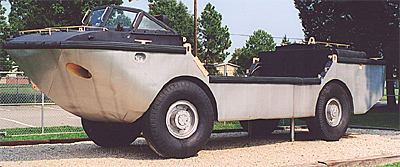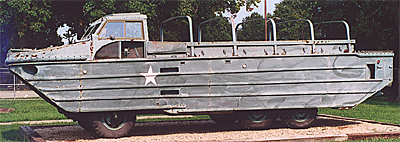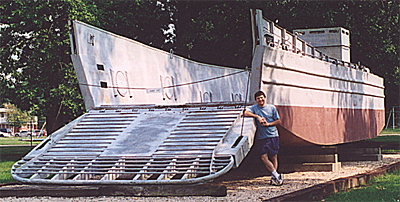Marine Park
Constructed in 1984, the Marine Park displays watercraft of the Transportation Corps. This guide begins at the visitor's entrance gate. Listed last are the large propellers displayed outside the fence on Washington Boulevard. While full-size watercraft is displayed outside, numerous models of Army watercraft are on display inside the museum.
FS ANCHOR. A pair of anchors on either side the entrance came from a standard World War II FS (Freight & Supply) ship.
DANFORTH ANCHOR & PROPELLERS, USA FS-790 "VIRGINIA". The anchor and two propellers are from the US Army Freight and Supply ship "VIRGINIA." The anchor is a Danforth type, manufactured by Baldt, weight 3,000 lbs. The propellers weight 2,500 lbs each. The FS790 was active from 1964-1992, and was assigned to the 10th Transportation Battalion at Fort Eustis.
 LARC-V. On the left is the LARC-V (Lighter, Amphibious, Resupply, Cargo, 5-ton), 4 x 4. This was developed under direction of the US Transportation Engineering Command at Fort Eustis in 1958 to replace the aging World War II DUKWs. The Army awarded the first production contract in June 1961 to Le Tourneau-Westinghouse and a total of 950 were built between 1962-1968. The cargo area in the center could carry 5 tons of cargo or 15 to 20 fully equipped troops from ships off shore to the beach or farther inland.
LARC-V. On the left is the LARC-V (Lighter, Amphibious, Resupply, Cargo, 5-ton), 4 x 4. This was developed under direction of the US Transportation Engineering Command at Fort Eustis in 1958 to replace the aging World War II DUKWs. The Army awarded the first production contract in June 1961 to Le Tourneau-Westinghouse and a total of 950 were built between 1962-1968. The cargo area in the center could carry 5 tons of cargo or 15 to 20 fully equipped troops from ships off shore to the beach or farther inland.
The LARC-V was powered by a Cummins 4-cycle V-8 diesel engine developing 300-hp. It had a road speed of 30-mph and a water speed of 9 knots per hour. Like the DUKW, tire pressure was regulated from with the cockpit. The US Coast Guard used this particular LARC-V at the Virginia Beach station until 1967, when it was returned to the Army.
 XM-147, "SUPER DUKW." Next to the LARC-V is the "Super DUKW," an experimental vehicle which preceded the LARC-V. It was tested in July 1954 at Monterey, California near Fort Ord. The Super DUKW's design was similar to the DUKW (displayed under cover near the Rail Yard), but with much larger dimensions, and weighed 6,500 pounds.
XM-147, "SUPER DUKW." Next to the LARC-V is the "Super DUKW," an experimental vehicle which preceded the LARC-V. It was tested in July 1954 at Monterey, California near Fort Ord. The Super DUKW's design was similar to the DUKW (displayed under cover near the Rail Yard), but with much larger dimensions, and weighed 6,500 pounds.
MARINE DIESEL SHIP ENGINE. On the opposite side of the Super DUKW is a 6-cylinder, four stroke vertical marine engine. It generated 400-hp and allowed for standard and opposite rotation (direct reversible). Manufactured by Enterprise Engine and Foundry, this Model DMG-6 weighed 35,000 lbs and was often used on large tugs, as it required no transmission to change from forward to reverse. It was cutaway for training purposes at the Transportation School from the 1970s to late 1980s.
VERTICAL AXIS PROPELLER. Next to the Marine diesel engine is the first vertical axis propeller, manufactured by Pacific Car & Foundry, Renton, Washington under contract to the Army.
Two such propellers were installed in the BDL "JOHN U. D. PAGE" (Beach Discharge Lighter). The BDL PAGE was developed to support port operations by transferring heavy vehicular and oversize cargo from ships off short to undeveloped beaches. The BDL was large enough (338 ft long, with a 65-ft beam) to proceed overseas under its own power. It could land cargo on shallow beaches with a draft of 4 feet forward and 10 feet aft. The vertical axis propeller made it possible to control pitch, and throw the full thrust of the engines in any direction. This allowed the BDL to move sideways, to turn without forward motion, to maneuver alongside cargo ships, or to remove itself from beaches with the ease of much smaller craft. This propeller system was also used on the large tug, LT 2194, built in 1953.
At the keel laying of the BDL in 1956, it was memorialized for LTC John U. D. Page. LTC Page, an artillery officer was attached to the 52' Transportation Truck Battalion in Korea. He was the recipient of the Medal of Honor for conspicuous gallantry and intrepidity in action beyond the call of duty near the Chosin Reservoir, Korea, in 1950.
LARC-XV. Across from the Vertical Axis Propeller is another in the LARC series, the LARCXV, 15-ton, developed after extensive studies of World War II cargo delivery problems. From the Army's Transportation Research Command, the design specifications were first built by the Ingersoll-Kalamazoo Division of Borg-Warner Corporation in Michigan. First production contracts were awarded to Fruehauf Corporation in 1963, and 24 LARC-XVs were issued to each Army medium amphibian company.
Designed to carry 15 tons of cargo from ships off shore onto the beach, a typical load might be a 155mm howitzer together with its crew and ammunition, or a 2-1/2 ton cargo truck. The hull is aluminum framed and plated, with a stern engine room. The flush cargo deck permitted unloading from the sides with conventional forklift equipment.
The LARC-XV was capable of operations in surf up to 10 ft high. Carrying a 15-ton payload at speeds of 9.7-mph in water and up to 20-mph on highways, it was powered by two 270-hp Cummins industrial engines. Its water speed was about twice that of the DUKW while carrying 6 times the amount of cargo. Drivers could select 2-wheel, 4wheel, or oblique (crab) steering on land. For marine operations, mechanical steering used both the wheels and the rudder. To provide optimum visibility, the hatch cover in the cab opened and the marine steering wheel rotated to a raised position. Together with the development of the LARC-V, the LARC-XV was termed the greatest advance in military amphibious craft in 20 years.
 LCM-6. To the right of the LARC-XV is a US Navy design; the LCM-6 (Landing Craft, Mechanized) was used by Army amphibious assault units from World War II to the early 1960s, replacing the LCM-8. The pilothouse sits over the engine compartment, which holds two 225-hp engines.
LCM-6. To the right of the LARC-XV is a US Navy design; the LCM-6 (Landing Craft, Mechanized) was used by Army amphibious assault units from World War II to the early 1960s, replacing the LCM-8. The pilothouse sits over the engine compartment, which holds two 225-hp engines.
With 95 degree temperature and high humidity that day in Virginia, the weather offered little in common with North Pole conditions. MagWeb.com CEO Russ Lockwood poses in summer survival gear. Photo by Susan Lockwood.
The 4th Transportation Terminal Command used LCM-6s in support of the USAF Northeast Air Command's Project-572 at the North Pole in the 1960s. This largest and longest-lived Arctic program provided terminal services to the DEW Line (Defense Early Warning) sites across the top of the continent, where they discharged cargo from freighters across unimproved, ice-bound beaches.
ST-2031. Near the LCM-6 is the ST-2031 (Small Tug), a standard Army 45-foot tugboat built in 1952. Tugboats are used for mooring large vessels, towing barges and other general harbor duties, and range in size from 45 to 150 feet. Powered by one 200-hp engine, the small tug is used as a harbor workboat. Its crew of 4 sleeps on board only when necessary. This vessel was last assigned to the 73`d Transportation Company, Third Port at Fort Eustis.
BARC-3X. Across from the small tug is the BARC-3X, the experimental version of the LARCLX, a 60-ton amphibious vehicle currently used at Fort Story, Virginia, the amphibious training facility for the Transportation Corps.
Developed in 1950 and tested under the guidance of General Franks S. Besson, Jr., the BARC (Beach, Amphibious, Resupply, Cargo), was nicknamed "Besson's Ark." The Transportation Corps awarded the LARC-LX contract to Pacific Car and Foundry, Renton, Washington in 1951. Designed to transport men, cargo and vehicles from ships offshore onto the beach, 15 were issued per amphibious company. The LARC-LX can carry 60 tons of cargo or 200 fully equipment soldiers. In an emergency, the vehicle can carry up to 100 tons of cargo.
Cargo is loaded overhead when alongside ships, and unloaded via the hydraulically operated bow ramp onto the beach. Each of the four 6-cylinder General Motors diesel engines, develop 165-hp each on land, powers one of the 4 road wheels. When afloat, the 2 port engines power the port propeller and the 2 starboard engines power the starboard propeller. Power is transmitted via Allison torque converters and torquematic transmissions. The tires have a central tire-pressure regulation system. Maximum road speed when empty is 20-mph and water speed empty is 8 knots per hour.
J-BOAT. In front of the BARC is the J-Boat, or picket boat, used by Transportation Corps personnel for transportation of personnel from ship-to-ship and ship-to-shore, and for command and control. Built by Lock City Machine and Marine of Michigan, this Design 4003 boat is powered by two 156-hp engines, and weighs ten long tons.
LARGE PROPELLER. The two large propellers along Washington Boulevard are from merchant ships built as part of an emergency program in World War II. The prop on the right came from a Liberty ship that was 441 ft long, cruised at 11 knots, and displaced 10-1/2 tons. Simple, rugged vessels, there were over 2,600 Liberty ships built. The slight smaller C-1 prop on the left came from a later design, and was removed from a ship in the James River Reserve Fleet.
More Fort Eustus US Army Transportation Museum
- Introduction
Museum Building
Railroad Park
Cargo Handling Yard
Aviation Pavilion
Marine Park
Summary
Back to List of Historic Sites
Back to Travel Master List
Back to MagWeb Master List of Magazines
© Copyright 2003 by Coalition Web, Inc.
This article appears in MagWeb (Magazine Web) on the Internet World Wide Web.
Other articles covering military history and related topics are available at http://www.magweb.com